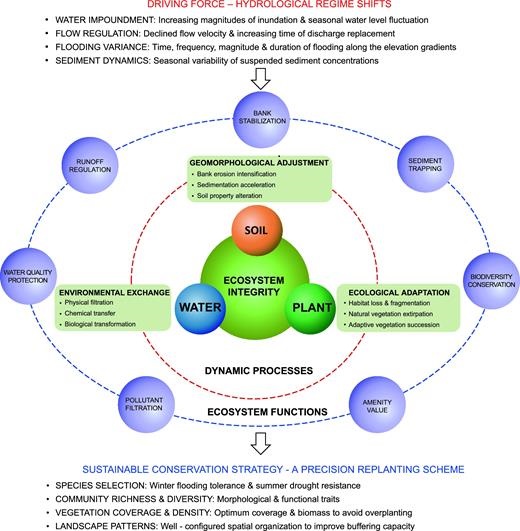The marginal landscape of the Three Gorges Reservoir, commonly referred to as the water-level fluctuation zone exhibit significant degradation because of accelerated bank erosion, original vegetation loss and accumulation of contaminants. A recent study reveals that absolute particle size differentiation explains flow regulation controls on sediment sorting in the water-level fluctuation zone. A longitudinal fining trend and seasonal variability in particle size composition for suspended sediment was found. Sink sediment during a single summer flood event displayed a similar longitudinal fining trend, reflecting preferentially settling of coarser fractions in the backwater reaches. Surface sediment demonstrated a laterally coarsening trend with increasing elevations along a slope profile. Flooding duration, frequency and timing represent key factors in determining lateral variations in the magnitude of sedimentation and its source inputs. Vertical particle size variability was observed along a sedimentary core profile, which most likely reflects seasonal differences in source supply with contrasting particle size characteristics.
Vegetation restoration is critical in view of the core concept of ecosystem integrity, due to recognition that plant cover can supply a series of complementary services. Based on the shortcomings that contemporary restoration actions are facing, a refined precision replanting scheme was proposed to maximize benefits but eliminate adverse unintended consequences relating to release of excessive amounts of nutrients and contaminants into the water body. An improved conservation strategy for the reservoir marginal landscape must include a diversified plant community in terms of structure and functional traits, optimized plant density and coverage, as well as well-configured spatial organization.
The study entitled Particle size differentiation explains flow regulation controls on sediment sorting in the water-level fluctuation zone of the Three Gorges Reservoir, China has been published online in Science of the Total Environment and the study entitled Developing a sustainable strategy to conserve reservoir marginal landscapes has been published online in National Science Review.

Figure 1. Flow regulation has resulted in dramatic hydrological regime shifts within the dammed channels (Image by TANG Qiang).
Contact:
Dr. TANG Qiang
Institute of Mountain Hazards and Environment, Chinese Academy of Sciences
Chengdu, Sichuan, 610041, China
Tel: 86-15908198809
E-mail: qiangtang@imde.ac.cn
